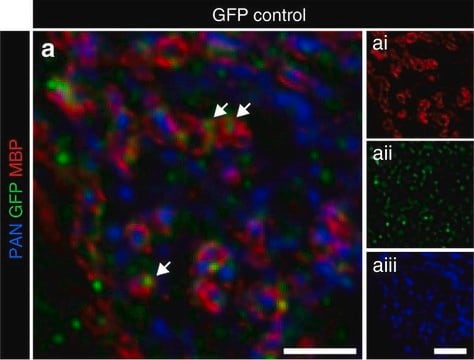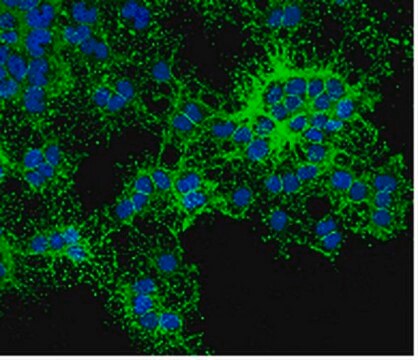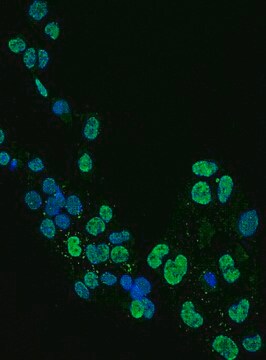MAB345M
Anti-O4 Antibody, clone 81
clone 81 (mAB O4), Chemicon®, from mouse
Sinónimos:
Sulfatide
About This Item
Productos recomendados
origen biológico
mouse
Nivel de calidad
100
300
forma del anticuerpo
purified immunoglobulin
tipo de anticuerpo
primary antibodies
clon
81 (mAB O4), monoclonal
reactividad de especies
rat, mouse, human, chicken
fabricante / nombre comercial
Chemicon®
técnicas
immunocytochemistry: suitable
immunohistochemistry: suitable
isotipo
IgM
idoneidad
not suitable for Western blot
not suitable for immunoprecipitation
Condiciones de envío
wet ice
modificación del objetivo postraduccional
unmodified
Especificidad
Aplicación
Immunocytochemistry: 10-20 μg/mL on cells fixed with 4% paraformaldehyde.
Note: O4 is a sulfatide, which can be dissolved out of the membrane by organic solvents; acetone and methanol should not be used for fixation.
Optimal working dilutions must be determined by the end user.
Immunohistochemistry protocol
1. Prepare sections from unfixed, shock frozen tissue. The sections should be 4-5 μm thick. Place the sections on microscope slides.
2. Wash the slide three times for 5 min. each in PBS at room temperature.
3. Block the non-specific binding sites by incubating the sections in a humid chamber with 5% FCS at room temperature for 30 minutes.
4. Wash the slides as described in step 2.
5. Cover the sections with a sufficient amount of MAB345 (10-20 μg/mL in PBS) and incubate in a humid chamber at 37°C for one hour.
6. Wash the slides briefly three times with PBS. Carefully dry around the area to be stained.
7. Cover the sections with a sufficient amount of anti-mouse IgM-fluorescein* solution and incubate in a humid chamber at 37°C for one hour.
8. Wash the slides as described in step 6.
9. Cover the sections with a suitable embedding medium, cover with a cover slip, and examine by fluorescence microscopy.
*HRP or ABC can also be used.
Optimal results can be obtained by titrating the primary and secondary antibodies
Immunocytochemistry
1. Fix the preparations with 4% paraformaldehyde (in PBS) at room temperature for 10 minutes. O4 is a sulfatide which can be dissolved out of the membrane by organic solvents; acetone and methanol should not be used for fixation.
2. Wash the slide three times for 5 min. each in PBS at room temperature.
3. Block the non-specific binding sites by incubating the sections in a human chamber with 5% FCS at room temperature for 30 minutes.
4. Wash the slides as described in step 2.
5. Cover the sections with a sufficient amount of MAB345 (10-20 μg/mL in PBS) and incubate in a humid chamber at 37°C for one hour.
6. Wash the slides briefly three times with PBS. Carefully dry around the area to be stained.
7. Cover the sections with a sufficient amount of anti-mouse IgM-fluorescein solution and incubate in a humid chamber at 37°C for one hour.
8. Wash the slides as described in step 6.
9. Cover the sections with a suitable embedding medium, cover with a cover slip, and examine by fluorescence microscopy.
Note: Do not allow the preparations to dry out during staining.
Forma física
Nota de análisis
Rat cortical stem cells or day 3 cell cultures of brains from mouse embryos
Otras notas
Información legal
¿No encuentra el producto adecuado?
Pruebe nuestro Herramienta de selección de productos.
Código de clase de almacenamiento
10 - Combustible liquids
Clase de riesgo para el agua (WGK)
WGK 2
Certificados de análisis (COA)
Busque Certificados de análisis (COA) introduciendo el número de lote del producto. Los números de lote se encuentran en la etiqueta del producto después de las palabras «Lot» o «Batch»
¿Ya tiene este producto?
Encuentre la documentación para los productos que ha comprado recientemente en la Biblioteca de documentos.
Nuestro equipo de científicos tiene experiencia en todas las áreas de investigación: Ciencias de la vida, Ciencia de los materiales, Síntesis química, Cromatografía, Analítica y muchas otras.
Póngase en contacto con el Servicio técnico








